Recent Advances of Electrode Materials Applied in an Electrochromic Supercapacitor Device
Abstract
1. Introduction
2. Fundamentals of Electrochromic and Supercapacitor Devices
2.1. Supercapacitor Devices
2.2. Electrochromic Devices
3. Inorganic Materials
3.1. Transition Metal Oxides
3.1.1. Tungsten Oxide
3.1.2. Nickel Oxide
| Electrode Material | ΔT% | Coloring Efficiency | Specific Capacitance | References |
|---|---|---|---|---|
| Molybdenun-doped WO3 | 56.7% | 123.5 cm2 C−1 | 55.89 F g−1 | [46] |
| WO3 polycrystalline | 76.2% | 54.8 cm2 C−1 | 639.8 F g−1 | [48] |
| WO3 | - | 140 cm2 C−1 | 68.4 mF cm−2 | [49] |
| NiO nanoparticle | 63.6% | 42.8 cm2 C−1 | 1386 F g−1 | [52] |
| NiO nanosheet | 40% | 63.2 cm2 C−1 | 74.8 mF cm−2 | [53] |
| NiO/Ag/NiO | 70% | 76.6 cm2 C−1 | 364 F g−1 | [54] |
| Silver nanowire/NiO | 15% | 51.9 cm2/C | 3.47 mF cm−2 | [55] |
| PANI nanowire arrays | 60% | - | 17 mF cm−2 | [56] |
| PProDOT-Me2 | - | - | 55 F g−1 | [57] |
| PDThOB | - | - | 112.4 F g−1 | [58] |
| Poly(3,4-dibromothiophene) | 43% | 357 cm2 C−1 | 229.6 F g−1 | [59] |
| PCDB-EDOT | 25% | 158 cm2 C−1 | 4.65 mF cm−2 | [60] |
| PThQ-Ph | 80% | 300 cm2 C−1 | 1.58 mF cm−2 | [61] |
| PC10QA-2EDOT | 40% | 498 cm−2 C−1 | 322 F cm−3 | [62] |
| PANI/WO3 nanocomposite | 35.3% | 98.4 cm−2 C−1 | 0.025 F cm−2 | [63] |
| PANI/MoO3−x composite | 33% | - | 606 F g−1 | [64] |
| PICA/TiO2 composite | 36% | 124 cm2/C | 23.34 mF cm−2 | [65] |
| P5ICA/WO3 composite | - | - | 30.2 mF cm−2 | [66] |
| PB/P5ICA composite | 60.1% | 262 cm2/C | 98.12 mF cm−2 | [67] |
3.2. Inorganic Nonmetallic Oxide
4. Organic Materials
4.1. Organic Conducting Polymer
4.1.1. Polyaniline
4.1.2. Polythiophene
4.2. Viologen Small Molecules
5. Inorganic/Organic Composite Materials
5.1. Transition Metal Oxides/Conducting Polymer Composite Materials
5.2. Other Inorganic/Organic-Based Composite Materials
6. Current Research Challenges
7. Future Perspectives
8. Conclusions
Author Contributions
Funding
Institutional Review Board Statement
Informed Consent Statement
Data Availability Statement
Conflicts of Interest
References
- Sriram, G.; Hegde, G.; Dhanabalan, K.; Kalegowda, Y.; Mouraliraman, D.; Vishwanath, R.S.; Kurkuri, M.; Oh, T.H. Recent trends in hierarchical electrode materials in supercapacitor: Synthesis, electrochemical measurements, performance and their charge-storage mechanism. J. Energy Storage 2024, 94, 112454. [Google Scholar] [CrossRef]
- Chernysheva, D.V.; Smirnova, N.V.; Ananikov, V.P. Recent trends in supercapacitor research: Sustainability in energy and materials. ChemSusChem 2024, 17, e202301367. [Google Scholar] [CrossRef]
- Li, J.; Li, Y.; Liu, H.; Ran, F. Nano gold for supercapacitors and batteries. Nano Energy 2024, 128, 109839. [Google Scholar] [CrossRef]
- Ma, L.; Li, F.; Zhou, M.; Dong, J.; Luo, H.; Zhang, W.; Zhao, W.; Li, X.; Jiang, Z.; Huang, Y. Phase reconfiguration of heterogeneous CoFeS/CoNiS nanoparticles for superior battery-type supercapacitors. J. Energy Chem. 2024, 96, 217–225. [Google Scholar] [CrossRef]
- Xu, C.; Tong, L.; Zhang, W.; Zhao, X.; Yang, L.; Yin, S. One-step synthesis of g-C3N4/TiVCTx MXene electrodes for lithium-ion batteries and supercapacitors. Chem. Eng. J. 2024, 497, 154449. [Google Scholar] [CrossRef]
- Li, K.; Zhang, J. Recent advances in flexible supercapacitors based on carbon nanotubes and graphene. Sci. China Mater. 2018, 61, 210–232. [Google Scholar] [CrossRef]
- Zhao, J.; Burke, A.F. Electrochemical capacitors: Materials, technologies and performance. Energy Storage Mater. 2021, 36, 31–35. [Google Scholar] [CrossRef]
- Hou, S.; Zhang, G.; Zeng, W.; Zhu, J.; Gong, F.; Li, F.; Duan, H. Hierarchical core–shell structure of ZnO nanorod@ NiO/MoO2 composite nanosheet arrays for high-performance supercapacitors. ACS Appl. Mater. Interfaces 2014, 6, 13564–13570. [Google Scholar] [CrossRef] [PubMed]
- Song, Z.; Duan, H.; Li, L.; Zhu, D.; Cao, T.; Lv, Y.; Xiong, W.; Wang, Z.; Liu, M.; Gan, L. High-energy flexible solid-state supercapacitors based on O, N, S-tridoped carbon electrodes and a 3.5 V gel-type electrolyte. Chem. Eng. J. 2019, 372, 1216–1225. [Google Scholar] [CrossRef]
- Zydlewski, B.Z.; Milliron, D.J. Dual-band electrochromic devices utilizing Niobium Oxide nanocrystals. ACS Appl. Mater. Interfaces 2024, 16, 24920–24928. [Google Scholar] [CrossRef] [PubMed]
- Zhang, L.; Liu, Y.; Wang, G.; Kuang, Y.; Xiang, X.; Chen, X.; Cai, Q.; Wang, K.; Lv, X. Advances in the visualization and thermal management of electrochromic materials. J. Mater. Chem. C 2024, 12, 15833–15854. [Google Scholar] [CrossRef]
- Ma, B.; Tang, L.; Zhang, Y.; Li, Z.; Zhang, J.; Zhang, S. Ionic gel electrolytes for electrochromic devices. ACS Appl. Mater. Interfaces 2024, 16, 48927–48936. [Google Scholar] [CrossRef]
- Yang, P.; Sun, P.; Mai, W. Electrochromic energy storage devices. Mater. Today 2016, 19, 394–402. [Google Scholar] [CrossRef]
- Mohanadas, D.; Sulaiman, Y. Recent advances in development of electroactive composite materials for electrochromic and supercapacitor applications. J. Power Sources 2022, 523, 231029. [Google Scholar] [CrossRef]
- Lv, X.; Xu, H.; Yang, Y.; Ouyang, M.; Xia, M.; Liu, C.; Wright, D.S.; Zhang, C. Flexible laterally-configured electrochromic supercapacitor with feasible patterned display. Chem. Eng. J. 2023, 458, 141453. [Google Scholar] [CrossRef]
- Kandpal, S.; Ghosh, T.; Rani, C.; Chaudhary, A.; Park, J.; Lee, P.S.; Kumar, R. Multifunctional electrochromic devices for energy applications. ACS Energy Lett. 2023, 8, 1870–1886. [Google Scholar] [CrossRef]
- Jiao, X.; Wang, J.; Yuan, Z.; Zhang, C. Smart current collector for high-energy-density and high-contrast electrochromic supercapacitors toward intelligent and wearable power application. Energy Storage Mater. 2023, 54, 254–265. [Google Scholar] [CrossRef]
- Ming, S.; Zhang, H.; Zhen, S.; Zhang, Y.; Lu, B.; Zhao, J.; Nie, G.; Xu, J. Influence of fluorine substitution position on electrochromic and capacitive properties of hybrid conjugated polymer. Dye. Pigment. 2022, 208, 110819. [Google Scholar] [CrossRef]
- Yang, H.; Chow, B.; Awoyomi, A.; D’Arcy, J.M. Nanostructured poly(3,4-ethylenedioxythiophene) coatings on functionalized glass for energy storage. ACS Appl. Mater. Interfaces 2023, 15, 3235–3243. [Google Scholar] [CrossRef] [PubMed]
- Beaujuge, P.M.; Reynolds, J.R. Color control in π-conjugated organic polymers for use in electrochromic devices. Chem. Rev. 2010, 110, 268–320. [Google Scholar] [CrossRef] [PubMed]
- Zhang, W.; Li, H.; Yu, W.W.; Elezzabi, A.Y. Transparent inorganic multicolour displays enabled by zinc-based electrochromic devices. Light Sci. Appl. 2020, 9, 121. [Google Scholar] [CrossRef] [PubMed]
- Pandit, B.; Dubal, D.P.; Sankapal, B.R. Large scale flexible solid state symmetric supercapacitor through inexpensive solution processed V2O5 complex surface architecture. Electrochim. Acta 2017, 242, 382–389. [Google Scholar] [CrossRef]
- Guo, L.; Hu, P.; Wei, H. Development of supercapacitor hybrid electric vehicle. J. Energy Storage 2023, 65, 107269. [Google Scholar] [CrossRef]
- Wang, Y. Nanowire materials for supercapacitor electrode: Preparation, performance and prospects. J. Energy Storage 2024, 97, 112848. [Google Scholar] [CrossRef]
- Khan, A.; Grabher, G.; Hossain, G. Smart-textile supercapacitor for wearable energy storage system. J. Energy Storage 2023, 73, 108963. [Google Scholar] [CrossRef]
- Salah, N.; Shehab, M.; El Nady, J.; Ebrahim, S.; El-Maghraby, E.M.; Sakr, A.H. Polyaniline/ZnS quantum dots nanocomposite as supercapacitor electrode. Electrochim. Acta 2023, 449, 142174. [Google Scholar] [CrossRef]
- Gao, C.; Liu, J.; Han, Y.; Chen, R.; Huang, J.; Gu, Y.; Zhao, Y.; Qu, L. An energy-adjustable, deformable, and packable wireless charging fiber supercapacitor. Adv. Mater. 2024, 36, 2413292. [Google Scholar] [CrossRef]
- Kang, S.; Kim, B.; Lee, S.; Baek, J.; Yoo, J. Tailoring porosity of starch-derived biocarbon for enhanced supercapacitor performance. Mater. Technol. 2024, 39, 2338628. [Google Scholar] [CrossRef]
- Elbasiony, A.M.; Abdelhamied, M.M.; AbdElrahman, M.; Said, B.A.M.; Awed, A.S. Ag-decorated ZnCo2S4/SiO2 nanocomposite as a high-performance supercapacitor electrode. J. Alloy. Compd. 2024, 1009, 176992. [Google Scholar] [CrossRef]
- Liang, F.; Wu, M.; Meng, J.; Yu, L.; Zhi, C. Research progress in conductive polymer-based electrochromic fabrics. Text. Res. J. 2023, 93, 5092–5111. [Google Scholar] [CrossRef]
- Constantin, C.P.; Damaceanu, M.D. A refreshing perspective on electrochromic materials: Phenoxazine as an opportune moiety towards stable and efficient electrochromic polyimides. Chem. Eng. J. 2023, 465, 142883. [Google Scholar] [CrossRef]
- Nuroldayeva, G.; Balanay, M.P. Flexing the spectrum: Advancements and prospects of flexible electrochromic materials. Polymers 2023, 15, 2924. [Google Scholar] [CrossRef]
- Li, J.; Zhang, L.; Cui, J.; Lv, X.; Feng, M.; Ouyang, M.; Chen, Z.; Wright, D.S.; Zhang, C. Hydrogen-bonding induced crosslinked polymer network for highly stable electrochromic device and a construction strategy for black-bilayer electrochromic film. Small 2023, 19, 2303359. [Google Scholar] [CrossRef]
- Mo, D.; Tong, T. Tunable optoelectronic performances of fluorinated benzene-EDOT based hybrid electrochromic polymers. Polymer 2024, 303, 127117. [Google Scholar] [CrossRef]
- Tang, Y.; Qiao, H.; Chen, X.; Huang, Z.; Qi, X. Performance optimization for multicolor electrochromic devices: Morphology and composition regulation of inorganic electrochromic materials and selectivity of Ions. Adv. Mater. Technol. 2024, 9, 2302139. [Google Scholar] [CrossRef]
- Guo, Q.; Sun, C.; Li, Y.; Li, K.; Tai, X. Facile preparation of high-performance polythiophene derivative and effect of torsion angle between thiophene rings on electrochromic color change. Molecules 2024, 29, 5477. [Google Scholar] [CrossRef] [PubMed]
- Jiang, Y.; Ma, Q.; Dong, S. Well-matched materials: Color palettes-like multicolor electrochromic displays. Appl. Mater. Today 2024, 37, 102119. [Google Scholar] [CrossRef]
- Ganesha, M.K.; Hakkeem, H.; Singh, A.K. Redox potential based self-powered electrochromic devices for smart windows. Small 2024, 20, 2403156. [Google Scholar] [CrossRef]
- Zhu, X.; Zong, H.; Viasus Pérez, C.J.; Miao, H.; Sun, W.; Yuan, Z.; Wang, S.; Zeng, G.; Xu, H.; Jiang, Z.; et al. Supercharged CO2 photothermal catalytic methanation: High conversion, rate, and selectivity. Angew. Chem. Int. Ed. 2023, 62, e202218694. [Google Scholar] [CrossRef]
- Feng, F.; Guo, S.; Ma, D.; Wang, J. An overview of electrochromic devices with electrolytes containing viologens. Sol. Energ. Mat. Sol. C. 2023, 254, 112270. [Google Scholar] [CrossRef]
- Yuan, Z.; Zhu, X.; Gao, X.; An, C.; Wang, Z.; Zuo, C.; Dionysiou, D.D.; He, H.; Jiang, Z. Enhancing photocatalytic CO2 reduction with TiO2-based materials: Strategies, mechanisms, challenges, and perspectives. Environ. Sci. Ecotechnol. 2024, 20, 100368. [Google Scholar] [CrossRef] [PubMed]
- Wu, W.; Wang, M.; Ma, J.; Cao, Y.; Deng, Y. Electrochromic metal oxides: Recent progress and prospect. Adv. Electron. Mater. 2018, 4, 1800185. [Google Scholar] [CrossRef]
- Poonam; Sharma, K.; Arora, A.; Tripathi, S.K. Review of supercapacitors: Materials and devices. J. Energy Storage 2019, 21, 801–825. [Google Scholar] [CrossRef]
- Nisa, M.U.; Nadeem, N.; Yaseen, M.; Iqbal, J.; Zahid, M.; Abbas, Q.; Mustafa, G.; Shahid, I. Applications of graphene-based tungsten oxide nanocomposites: A review. J. Nanostructure Chem. 2023, 13, 167–196. [Google Scholar] [CrossRef]
- Xie, S.; Bi, Z.; Chen, Y.; He, X.; Guo, X.; Gao, X.; Li, X. Electrodeposited Mo-doped WO3 film with large optical modulation and high areal capacitance toward electrochromic energy-storage applications. Appl. Surf. Sci. 2018, 459, 774–781. [Google Scholar] [CrossRef]
- Zhou, D.; Shi, F.; Xie, D.; Wang, D.; Xia, X.; Wang, X.; Gu, C.; Tu, J. Bi-functional Mo-doped WO3 nanowire array electrochromism-plus electrochemical energy storage. J. Colloid Interf. Sci. 2016, 465, 112–120. [Google Scholar] [CrossRef] [PubMed]
- Malik, G.; Mourya, S.; Hirpara, J.G.; Chandra, R. Surface modification of sputter deposited γ-WO3 thin film for scaled electrochromic behaviour. Surf. Coat. Technol. 2019, 375, 708–714. [Google Scholar] [CrossRef]
- Yang, P.; Sun, P.; Chai, Z.; Huang, L.; Cai, X.; Tan, S.; Song, J.; Mai, W. Large-scale fabrication of pseudocapacitive glass windows that combine electrochromism and energy storage. Angew. Chem. Int. Edit. 2014, 53, 11935–11939. [Google Scholar] [CrossRef]
- Chen, J.; Wang, Z.; Chen, Z.; Cong, S.; Zhao, Z. Fabry–Perot cavity-type electrochromic supercapacitors with exceptionally versatile color tunability. Nano Lett. 2020, 20, 1915–1922. [Google Scholar] [CrossRef] [PubMed]
- Sutar, S.H.; Babar, B.M.; Pisal, K.B.; Inamdar, A.I.; Mujawar, S.H. Feasibility of nickel oxide as a smart electrochromic supercapacitor device: A review. J. Energy Storage 2023, 73, 109035. [Google Scholar] [CrossRef]
- Lee, S.H.; Tracy, C.E.; Yan, Y.; Pitts, J.R.; Deb, S.K. Solid-state nanocomposite electrochromic pseudocapacitors. Electrochem. Solid-State. Lett. 2005, 8, A188–A190. [Google Scholar] [CrossRef]
- Cai, G.; Wang, X.; Cui, M.; Darmawan, P.; Wang, J.; Eh, A.L.S.; Lee, P.S. Electrochromo-supercapacitor based on direct growth of NiO nanoparticles. Nano Energy 2015, 12, 258–267. [Google Scholar] [CrossRef]
- Chen, Y.; Wang, Y.; Sun, P.; Yang, P.; Du, L.; Mai, W. Nickel oxide nanoflake-based bifunctional glass electrodes with superior cyclic stability for energy storage and electrochromic applications. J. Mater. Chem. A 2015, 3, 20614–20618. [Google Scholar] [CrossRef]
- Qin, S.; Zhang, Q.; Yang, X.; Liu, M.; Sun, Q.; Wang, Z. Hybrid piezo/triboelectric-driven self-charging electrochromic supercapacitor power package. Adv. Energy Mater. 2018, 8, 1800069. [Google Scholar] [CrossRef]
- Dong, W.; Lv, Y.; Zhang, N.; Xiao, L.; Fan, Y.; Liu, X. Trifunctional NiO–Ag–NiO electrodes for ITO-free electrochromic supercapacitors. J. Mater. Chem. C 2017, 5, 8408–8414. [Google Scholar] [CrossRef]
- Wang, K.; Wu, H.; Meng, Y.; Zhang, Y.; Wei, Z. Integrated energy storage and electrochromic function in one flexible device: An energy storage smart window. Energy Environ. Sci. 2012, 5, 8384–8389. [Google Scholar] [CrossRef]
- Liu, D.Y.; Reynolds, J.R. Dioxythiophene-based polymer electrodes for supercapacitor modules. ACS Appl. Mater. Interfaces 2010, 2, 3586–3593. [Google Scholar] [CrossRef]
- Yuksel, R.; Cevher, S.C.; Cirpan, A.; Toppare, L.; Unalan, H.E. All-organic electrochromic supercapacitor electrodes. J. Electrochem. Soc. 2015, 162, A2805–A2810. [Google Scholar] [CrossRef]
- Guo, Q.; Du, C.; Deng, X.; Cheng, Y.; Tai, X.; Nie, G. High performance polythiophene derivative with good electrochromic and energy storage properties electrochemical synthesized in boron triffuoride diethyl etherate. Dye. Pigment. 2023, 220, 111709. [Google Scholar] [CrossRef]
- Huang, Q.; Chen, J.; Yan, S.; Shao, X.; Dong, Y.; Liu, J.; Li, W.; Zhang, C. New donor–acceptor-donor conjugated polymer with twisted donor–acceptor configuration for high-capacitance electrochromic supercapacitor application. ACS Sustain. Chem. Eng. 2021, 9, 13807. [Google Scholar] [CrossRef]
- Zhu, J.; Wang, W.; Chen, H.; Han, Y.; Liu, J. Electropolymerization of D–A–D type monomers consisting of thiophene and quionaxline moieties for electrochromic devices and supercapacitors. J. Solid State Chem. 2022, 307, 122739. [Google Scholar] [CrossRef]
- Lv, X.; Li, J.; Zhang, L.; Ouyang, M.; Tameev, A.; Nekrasov, A.; Kim, G.; Zhang, C. High-performance electrochromic supercapacitor based on quinacridone dye with good specific capacitance, fast switching time and robust stability. Chem. Eng. J. 2022, 431, 133733. [Google Scholar] [CrossRef]
- Wei, H.; Yan, X.; Wu, S.; Luo, Z.; Wei, S.; Guo, Z. Electropolymerized polyaniline stabilized tungsten oxide nanocomposite films: Electrochromic behavior and electrochemical energy storage. J. Phys. Chem. C 2012, 116, 25052–25064. [Google Scholar] [CrossRef]
- Sui, Y.; Ma, Y.; Gao, Y.; Song, J.; Ye, Y.; Niu, H.; Ma, W.; Zhang, P.; Qin, C. PANI/MoO3−x shell-core composites with enhanced rate and cycling performance for flexible solid-state supercapacitors and electrochromic applications. New J. Chem. 2021, 45, 10654–10663. [Google Scholar] [CrossRef]
- Guo, Q.; Li, J.; Zhang, B.; Nie, G.; Wang, D. High-performance asymmetric electrochromic-supercapacitor device based on poly(indole-6-carboxylicacid)/TiO2 Nanocomposites. ACS Appl. Mater. Interfaces 2019, 11, 6491–6501. [Google Scholar] [CrossRef]
- Guo, Q.; Zhao, X.; Li, Z.; Wang, B.; Wang, D.; Nie, G. High performance multicolor intelligent supercapacitor and its quantitative monitoring of energy storage level by electrochromic parameters. ACS Appl. Energy Mater. 2020, 3, 2727–2736. [Google Scholar] [CrossRef]
- Li, Q.; Wang, B.; Zou, H.; Guo, Q.; Nie, G. High performance multi-color prussian blue/poly(indole-5-carboxylic acid) nanocomposites with multiple layer nanosphere structure for electrochromic supercapacitor application. J. Alloy. Compd. 2022, 921, 166140. [Google Scholar] [CrossRef]
- Kraft, A. Too blue to be good? A critical overview on the electrochromic properties and applications of Prussian blue. Sol. Energ. Mat. Sol. C. 2024, 278, 113195. [Google Scholar] [CrossRef]
- Shan, Y.; Zhang, G.; Yin, W.; Pang, H.; Xu, Q. Recent progress in Prussian blue/Prussian blue analogue-derived metallic compounds. Bull. Chem. Soc. Jpn. 2022, 95, 230–260. [Google Scholar] [CrossRef]
- Kong, B.; Selomulya, C.; Zheng, G.; Zhao, D. New faces of porous Prussian blue: Interfacial assembly of integrated hetero-structures for sensing applications. Chem. Soc. Rev. 2015, 44, 7997–8018. [Google Scholar] [CrossRef]
- Bie, X.; Kubota, K.; Hosaka, T.; Chihara, K.; Komaba, S. Synthesis and electrochemical properties of Na-rich Prussian blue analogues containing Mn, Fe, Co, and Fe for Na-ion batteries. J. Power Sources 2018, 378, 322–330. [Google Scholar] [CrossRef]
- Wang, J.; Zhang, L.; Yu, L.; Jiao, Z.; Xie, H.; Lou, X.; Sun, X. A bi-functional device for self-powered electrochromic window and self-rechargeable transparent battery applications. Nat. Commun. 2014, 5, 4921. [Google Scholar] [CrossRef]
- Bi, Z.; Li, X.; Chen, Y.; He, X.; Xu, X.; Gao, X. Large-scale multifunctional electrochromic-energy storage device based on tungsten trioxide monohydrate nanosheets and prussian white. ACS Appl. Mater. Interfaces 2017, 9, 29872–29880. [Google Scholar] [CrossRef]
- Niu, J.; Zhang, J.; Wang, Y.; Hu, L.; Tang, S.; Wan, Z.; Jia, C.; Weng, X.; Deng, L. A light-weight, thin-thickness, flexible multifunctional electrochromic device integrated with variable optical, thermal management and energy storage. Electrochim. Acta 2022, 435, 141274. [Google Scholar] [CrossRef]
- Kiruthika, S.; Kulkarni, G.U. Smart electrochromic supercapacitors made of metal mesh electrodes with polyaniline as charge storage indicator. Energy Technol. 2020, 8, 1901364. [Google Scholar] [CrossRef]
- Tong, Z.; Lv, H.; Zhao, J.; Li, Y. Near-infrared and multicolor electrochromic device based on polyaniline derivative. Chin. J. Polym. Sci. 2014, 32, 1040–1051. [Google Scholar] [CrossRef]
- Tong, Z.; Yang, Y.; Wang, J.; Zhao, J.; Su, B.; Li, Y. Layered polyaniline/graphene film from sandwich-structured polyaniline/graphene/polyaniline nanosheets for high-performance pseudosupercapacitors. J. Mater. Chem. A 2014, 2, 4642–4651. [Google Scholar] [CrossRef]
- Zhou, K.; Wang, H.; Jiu, J.; Liu, J.; Yan, H.; Suganuma, K. Polyaniline films with modified nanostructure for bifunctional flexible multicolor electrochromic and supercapacitor applications. Chem. Eng. J. 2018, 345, 290–299. [Google Scholar] [CrossRef]
- He, Z.; Gao, B.; Li, T.; Liao, J.; Liu, B.; Liu, X.; Wang, C.; Feng, Z.; Gu, Z. Piezoelectric-driven self-powered patterned electrochromic supercapacitor for human motion energy harvesting. ACS Sustain. Chem. Eng. 2018, 7, 1745–1752. [Google Scholar] [CrossRef]
- Chen, X.; Lin, H.; Deng, J.; Zhang, Y.; Sun, X.; Chen, P.; Fang, X.; Zhang, Z.; Guan, G.; Peng, H. Electrochromic fiber-shaped supercapacitors. Adv. Mater. 2014, 26, 8126–8132. [Google Scholar] [CrossRef]
- Dyer, A.L.; Grenier, C.R.G.; Reynolds, J.R. A poly(3,4-alkylenedioxythiophene) electrochromic variable optical attenuator with near-infrared reflectivity tuned independently of the visible region. Adv. Funct. Mater. 2007, 17, 1480–1486. [Google Scholar] [CrossRef]
- Guo, Y.; Li, W.; Yu, H.; Perepichka, D.F.; Meng, H. Flexible asymmetric supercapacitors via spray coating of a new electrochromic donor–acceptor polymer. Adv. Energy Mater. 2017, 7, 1601623. [Google Scholar] [CrossRef]
- Zhang, P.; Zhu, F.; Wang, F.; Wang, J.; Dong, R.; Zhuang, X.; Schmidt, O.; Feng, X. Stimulus-responsive micro-supercapacitors with ultrahigh energy density and reversible electrochromic window. Adv. Mater. 2017, 29, 1604491. [Google Scholar] [CrossRef]
- Cho, J.; Yun, T.Y.; Noh, H.Y.; Baek, S.H.; Nam, M.; Kim, B.; Moon, H.C.; Ko, D.H. Semitransparent energy storing functional photovoltaics monolithically integrated with electrochromic supercapacitors. Adv. Funct. Mater. 2020, 30, 1909601. [Google Scholar] [CrossRef]
- Jang, Y.J.; Kim, S.Y.; Kim, Y.M.; Lee, J.K.; Moon, H.C. Unveiling the diffusion-controlled operation mechanism of all-in-one type electrochromic supercapacitors: Overcoming slow dynamic response with ternary gel electrolytes. Energy Storage Mater. 2021, 43, 20–29. [Google Scholar] [CrossRef]
- Zhang, S.; Lei, P.; Fu, J.; Tong, X.; Wang, Z.; Cai, G. Solution-processable multicolor TiO2/polyaniline nanocomposite for integrated bifunctional electrochromic energy storage device. Appl. Surf. Sci. 2023, 607, 155015. [Google Scholar] [CrossRef]
- Cai, G.; Darmawan, P.; Cheng, X.; Lee, P. Inkjet printed large area multifunctional smart windows. Adv. Energy Mater. 2017, 7, 1602598. [Google Scholar] [CrossRef]
- Tian, Y.; Cong, S.; Su, W.; Chen, H.; Li, Q.; Geng, F.; Zhao, Z. Synergy of W18O49 and olyaniline for smart supercapacitor electrode integrated with energy level indicating functionality. Nano Lett. 2014, 14, 2150–2156. [Google Scholar] [CrossRef]
- Zhang, S.; Hu, F.; Chen, S.; Du, Z.; Peng, H.; Yang, F.; Cao, Y. A dual-type electrochromic device based on complementary silica/conducting polymers nanocomposite films for excellent cycling stability. J. Electron. Mater. 2019, 48, 4797–4805. [Google Scholar] [CrossRef]
- Li, Z.; Wang, B.; Zhao, X.; Guo, Q.; Nie, G. Intelligent electrochromic-supercapacitor based on effective energy level matching poly(indole-6-carboxylicacid)/WO3 nanocomposites. New J. Chem. 2020, 44, 20584–20591. [Google Scholar] [CrossRef]
- Wang, Y.; Jia, X.; Zhu, M.; Liu, X.; Chao, D. Oligoaniline-functionalized polysiloxane/Prussian blue composite towards bifunctional electrochromic supercapacitors. New J. Chem. 2020, 44, 8138–8147. [Google Scholar] [CrossRef]
- Li, J.; Levitt, A.; Kurra, N.; Juan, K.; Noriega, N.; Xiao, X.; Wang, X.; Wang, H.; Alshareef, H.N.; Gogotsi, Y. MXene-conducting polymer electrochromic microsupercapacitors. Energy Storage Mater. 2019, 20, 455–461. [Google Scholar] [CrossRef]
- Ye, T.; Sun, Y.; Zhao, X.; Lin, B.; Yang, H.; Zhang, X.; Guo, L. Long-term-stable, solution-processable, electrochromic carbon nanotubes/polymer composite for smart supercapacitor with wide working potential window. J. Mater. Chem. A 2018, 6, 18994–19003. [Google Scholar] [CrossRef]
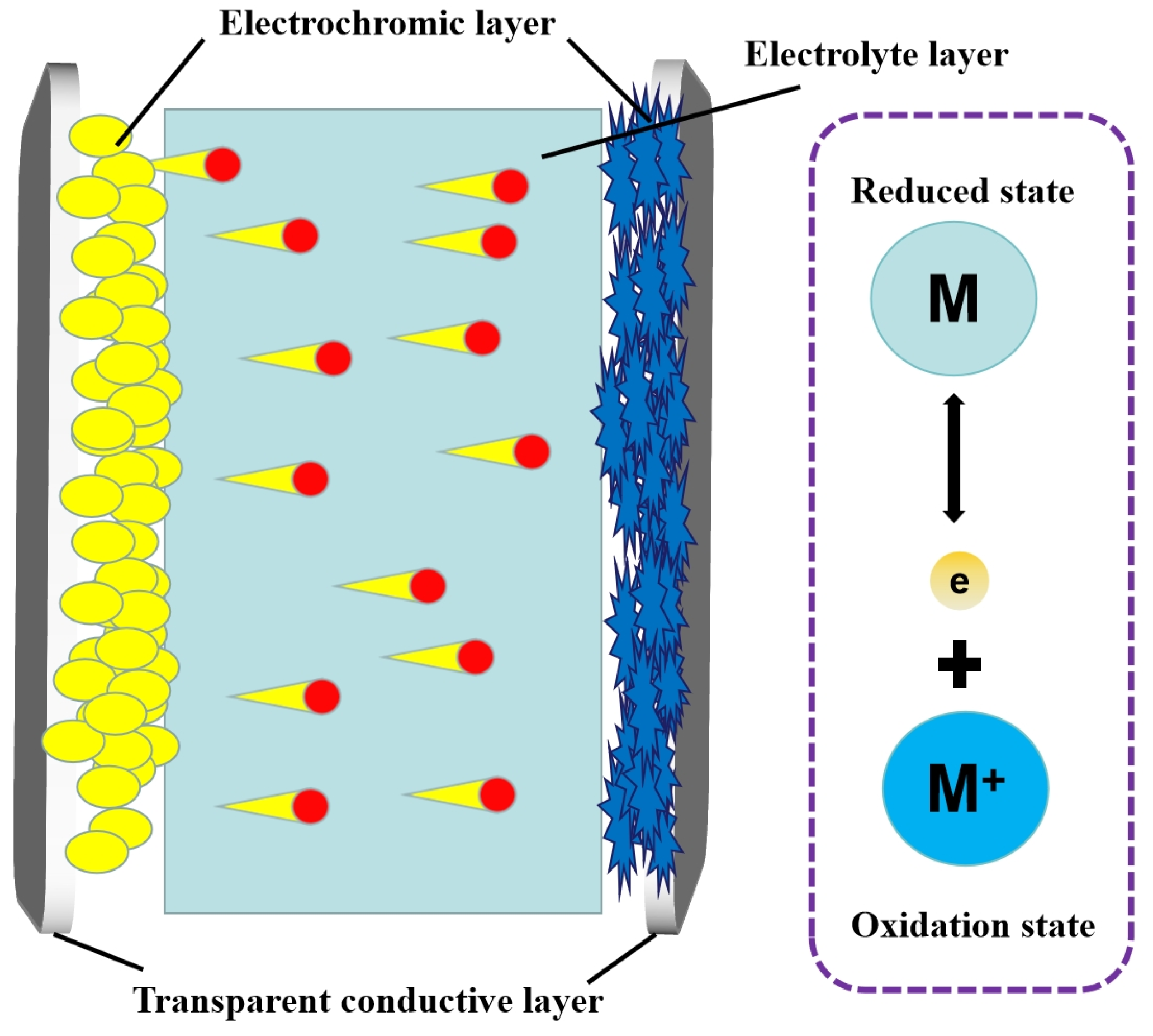
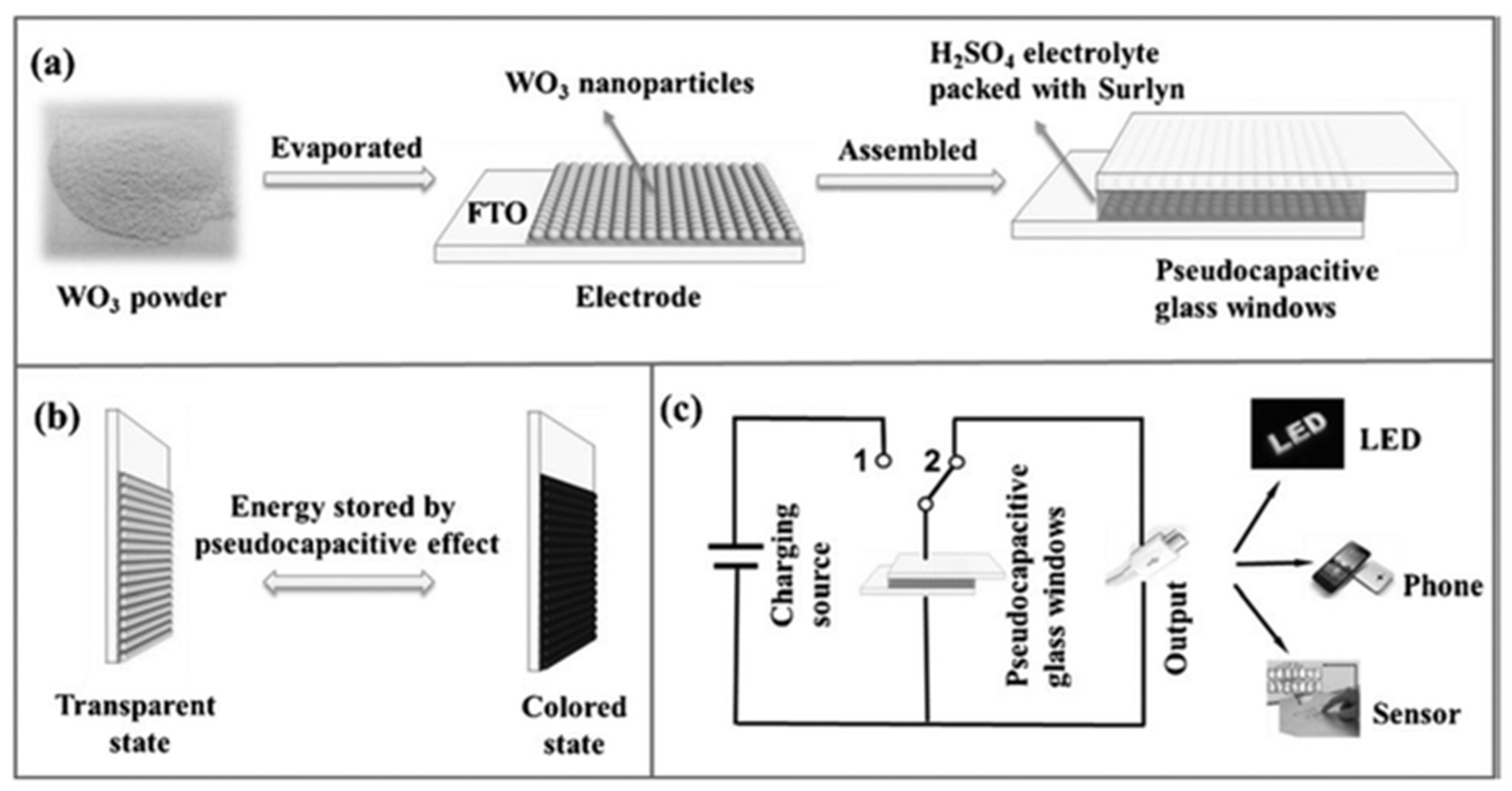

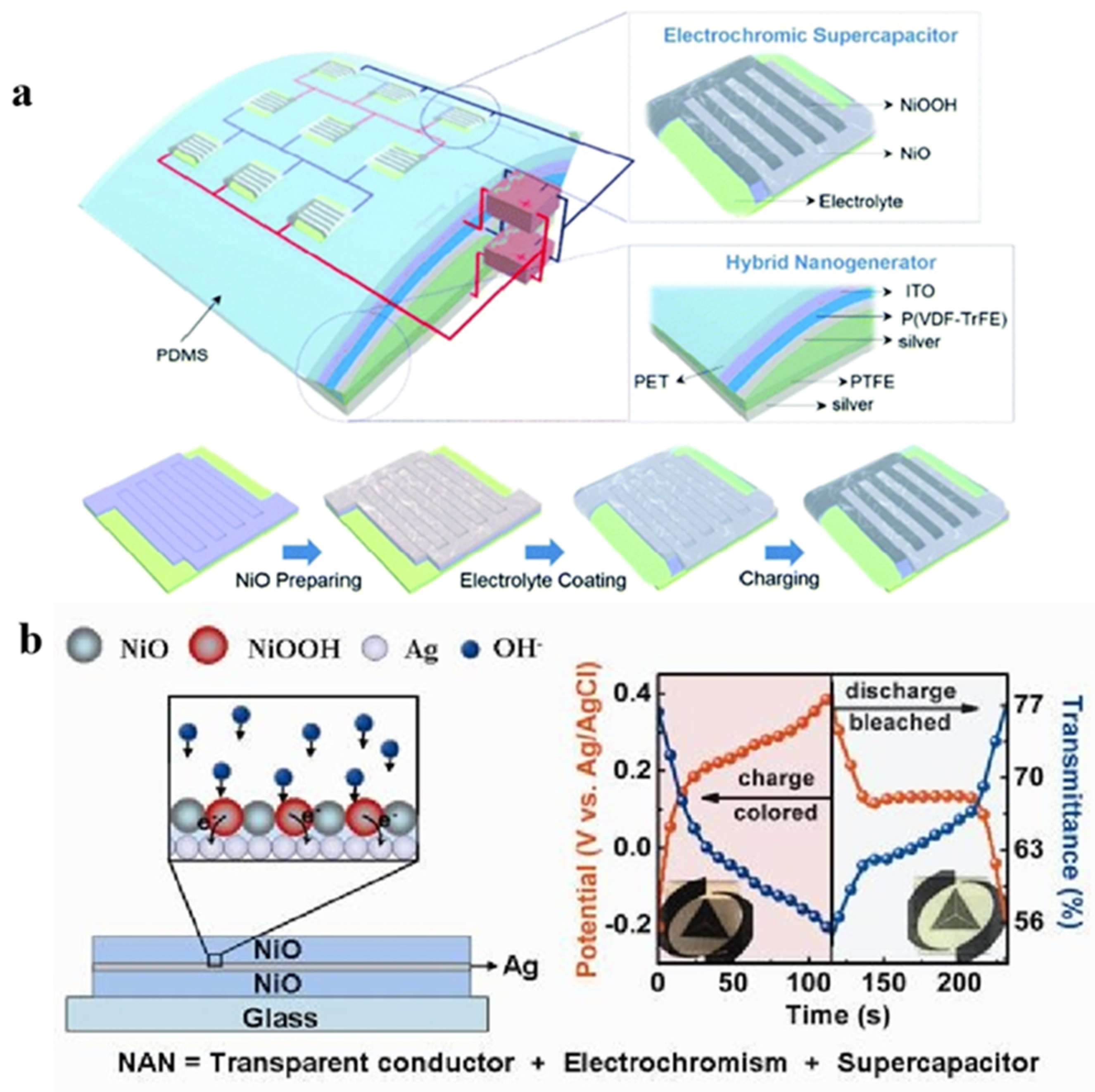
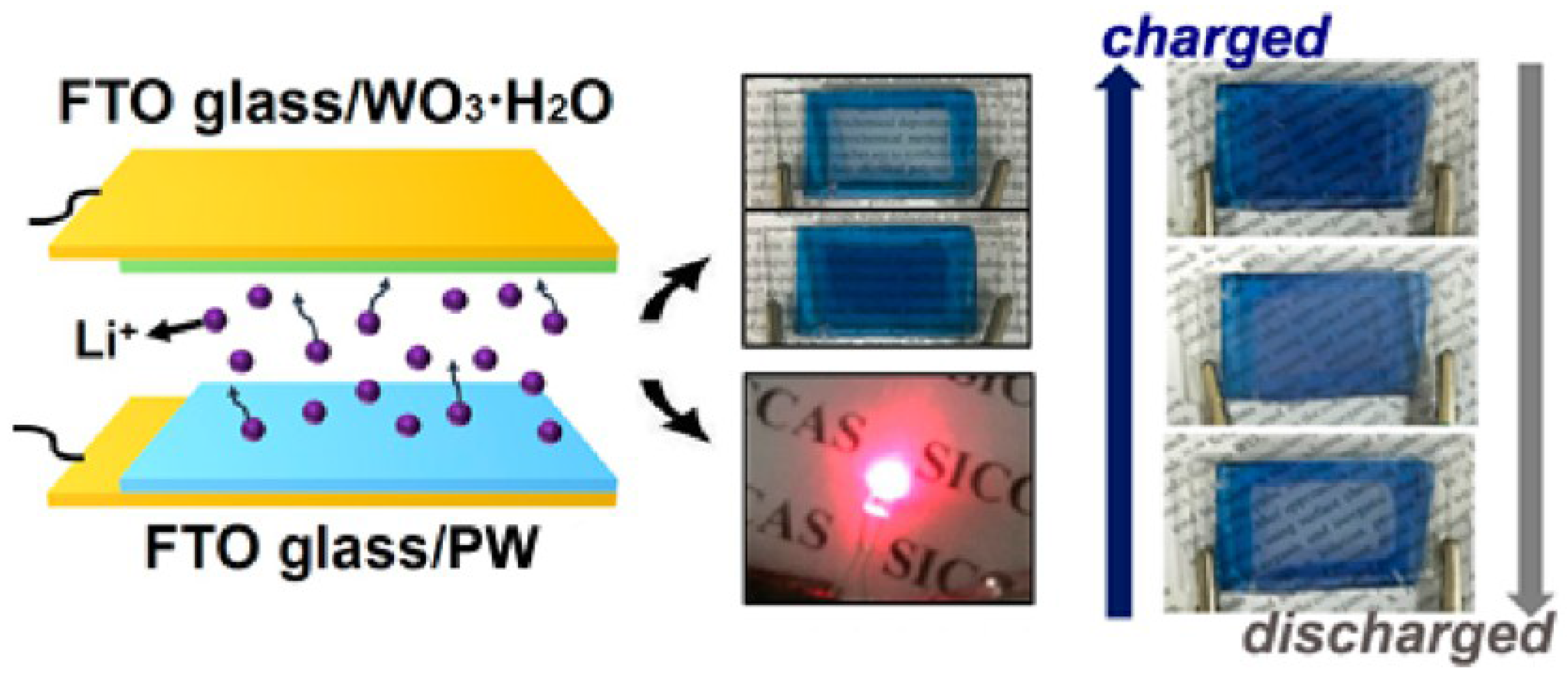




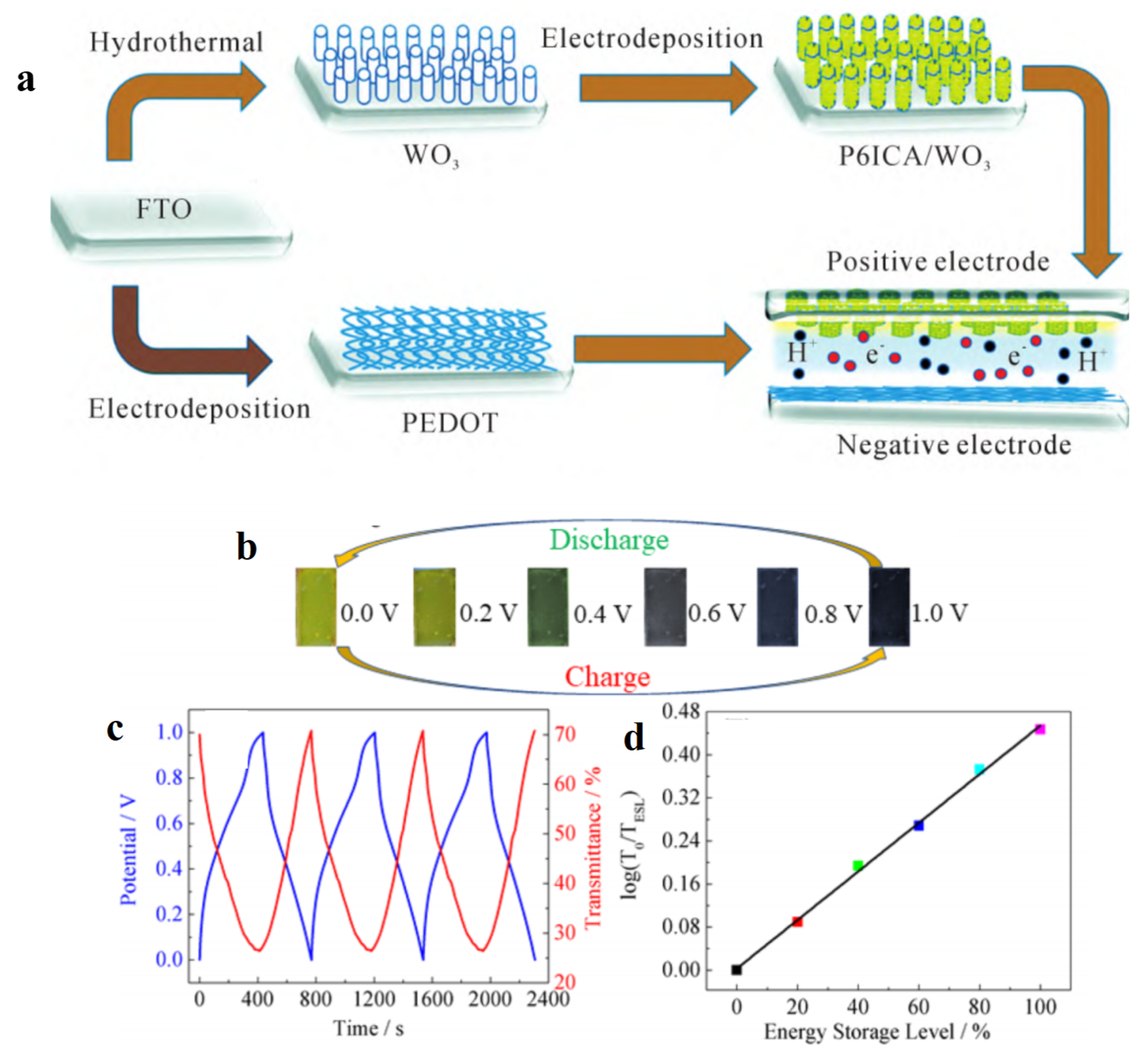
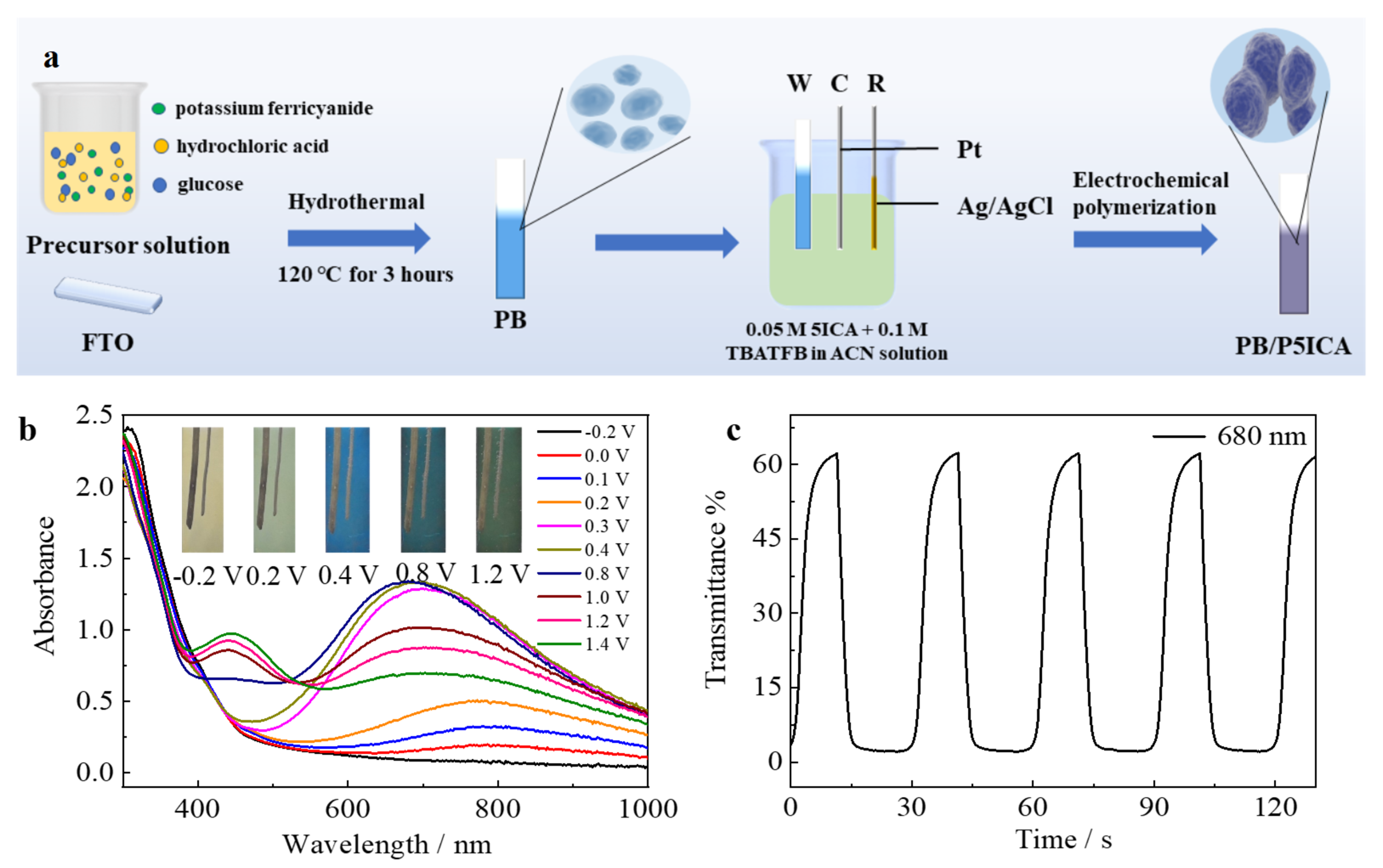
Disclaimer/Publisher’s Note: The statements, opinions and data contained in all publications are solely those of the individual author(s) and contributor(s) and not of MDPI and/or the editor(s). MDPI and/or the editor(s) disclaim responsibility for any injury to people or property resulting from any ideas, methods, instructions or products referred to in the content. |
© 2025 by the authors. Licensee MDPI, Basel, Switzerland. This article is an open access article distributed under the terms and conditions of the Creative Commons Attribution (CC BY) license (https://creativecommons.org/licenses/by/4.0/).
Share and Cite
Guo, Q.; Sun, C.; Li, Y.; Li, K.; Tai, X. Recent Advances of Electrode Materials Applied in an Electrochromic Supercapacitor Device. Molecules 2025, 30, 182. https://doi.org/10.3390/molecules30010182
Guo Q, Sun C, Li Y, Li K, Tai X. Recent Advances of Electrode Materials Applied in an Electrochromic Supercapacitor Device. Molecules. 2025; 30(1):182. https://doi.org/10.3390/molecules30010182
Chicago/Turabian StyleGuo, Qingfu, Chao Sun, Yiran Li, Kaoxue Li, and Xishi Tai. 2025. "Recent Advances of Electrode Materials Applied in an Electrochromic Supercapacitor Device" Molecules 30, no. 1: 182. https://doi.org/10.3390/molecules30010182
APA StyleGuo, Q., Sun, C., Li, Y., Li, K., & Tai, X. (2025). Recent Advances of Electrode Materials Applied in an Electrochromic Supercapacitor Device. Molecules, 30(1), 182. https://doi.org/10.3390/molecules30010182






